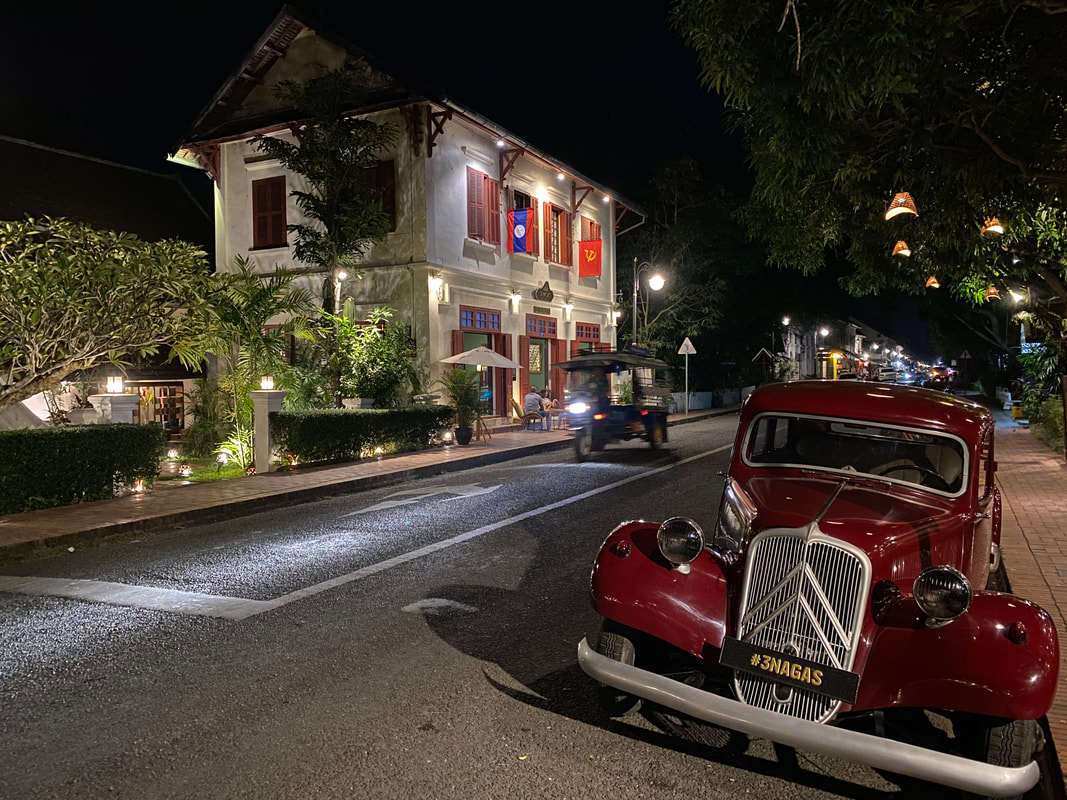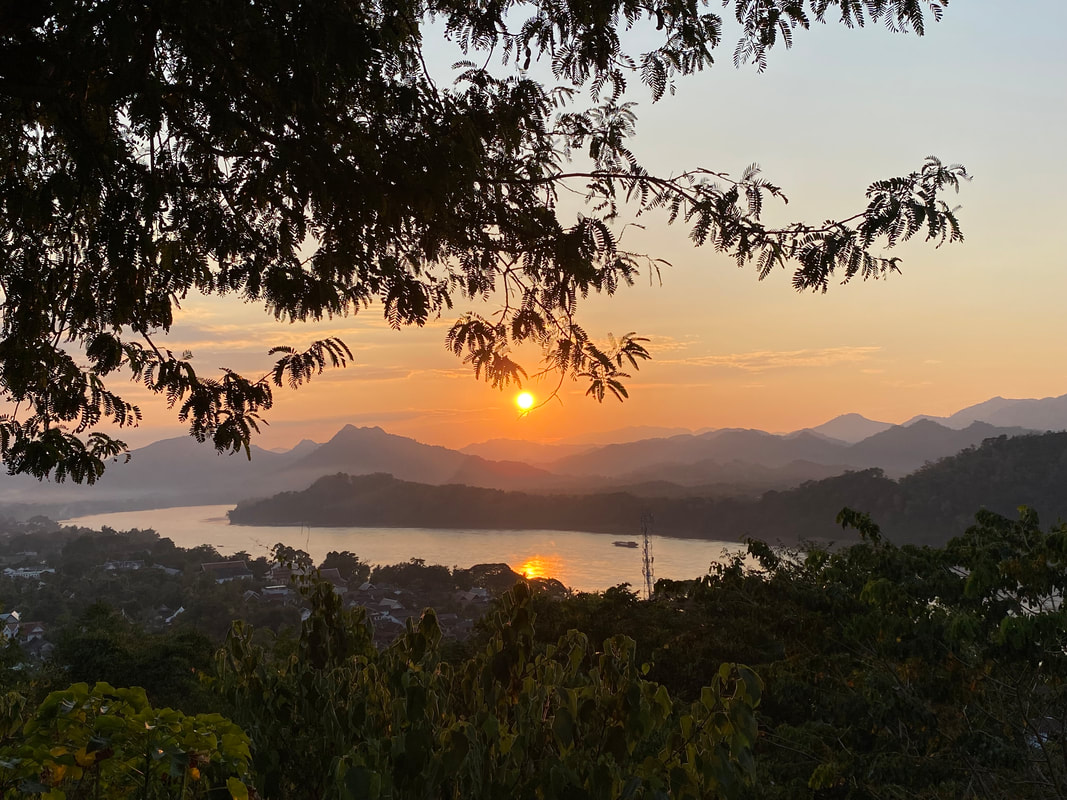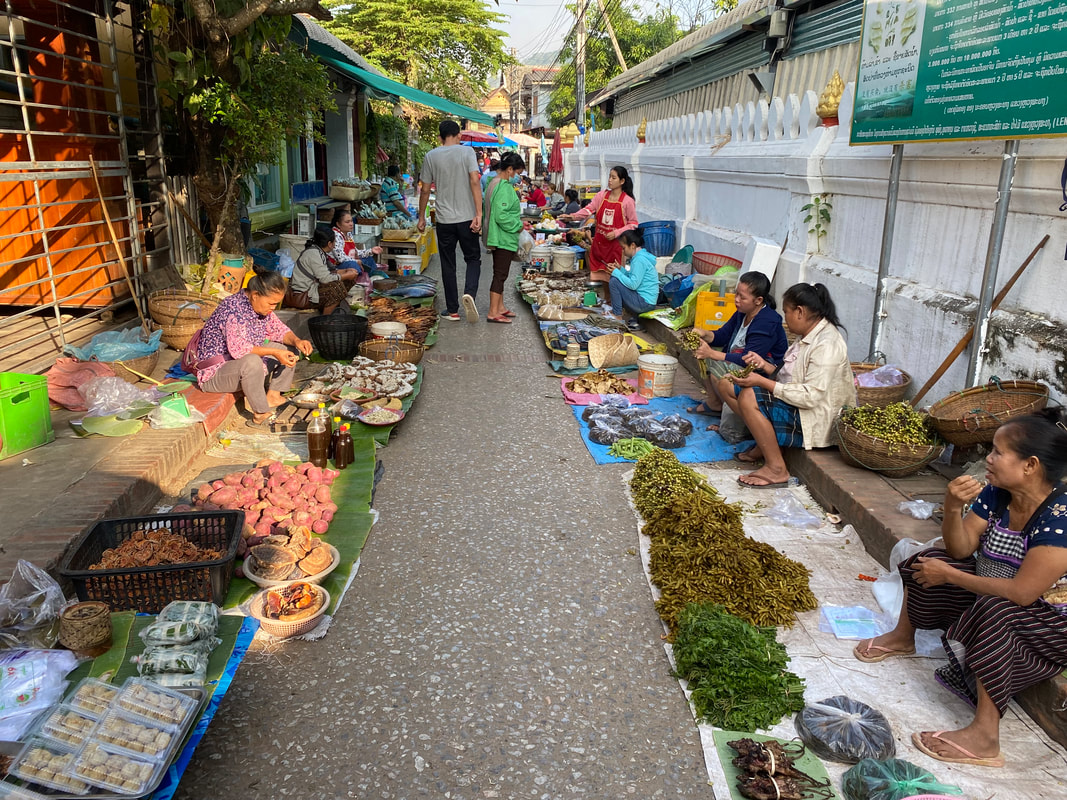SummaryAirport Rating ••••• Reception of locals ***** Cost: ££
Lao comes to lifeAfter waiting so many years to visit Lao, my first impression was fine if not slightly underwhelming. Vientiane began to grow on me, but I found it very much a functional capital built for the operation of government (you can read about my experience here). So it was with slight trepidation and lower hopes that I caught a short 45 minute flight from the current capital into Luang Prabang, the former capital. I soon discovered that the two cities are like night and day, and this is where Lao really comes to life. Luang Prabang is an old city, and has gone through various names over the centuries, Xieng Thong, Louangphabang and Luang Prabang. The name means “Buddha image” and is so named as an old Khmer King from neighboring Angkor (now in Cambodia) gave rule to his son-in-law with an image of Buddha to provide legitimacy to the role. The city’s power has also waxed and waned over the years, it has been a capital of several empires, kingdoms and protectorates, and it has also been invaded, demolished and deserted. The Thai, Vietnamese, Khmer and French have at various times had suzerainty over the city, with brief periods of independence in between. Following the withdrawal of the French, the government moved the seat of power to Vientiane from Luang Prabang. Today it is a relatively small but thriving city of around 56,000 people. The historical core is a UNESCO World Heritage Site and contains superb examples of 19th century French architecture, a reminder of the country’s colonial past. The trip from Vientiane to Luang Prabang was relatively straight forward. There were no issues as a Sikh flying out of Vientiane airport, a small international airport with few flights entering or leaving. The airport in Luang Prabang is even smaller and serves mostly domestic flights from the capital, with a handful of international flights also landing at the airport. Much like Vientiane, the airport is fairly close to the city, and a short 30 minute drive through beautiful villages and countryside got me into the historical core. Taxis are easy to find, and the cost is set out transparently to everyone so there is little chance of getting ripped off. Also similar to Vientiane is the situation with the trains. I caught a train back to the capital city and again the station is way outside the city and is preposterously grand considering the relative size of the city with a Chinese dominance inside the station. Given its strange location I often found myself wondering which local landowner got the windfall of cash here. Secondly, much like Vientiane, make sure if you have cash that it is clear with no marks on - this is especially important with US dollars. Vendors won't accept USD with even the slightest mark. A top-tier destinationI’m going to say it up front. This is comfortably one of the most beautiful cities I have ever visited and when I finally get around to ranking the cities that I’ve visited this will be near the top. There are caveats. I visited a couple of weeks after the end of the rainy season as well as following the lifting of covid restrictions. It meant the city was largely devoid of tourists. I can imagine during peak months with no restrictions, this place must be heaving, and I’m sure that would have changed my opinion. Much like Vientiane, the city is located on the banks of the Mekong River (as well as the Nam Khan), but that is pretty much where the similarities end. The historical core of Luang Prabang is nothing short of stunning. Mountains frame the backdrop, dense jungle as far as the eye can see extends from the riverside, while the city has gorgeous examples of French architecture that surpassed even the buildings I had seen in Hanoi. Man-made beautyThe entire city - even outside the historical core - has significant beauty in its architecture, but it is the historical core where the buildings really make you stop and stare. The French influence is immediately obvious when you walk down the main street. French buildings that today serve as bars, restaurants and schools dominate the area. Each building has a slightly different character, and while they are beautiful to admire at any point during the day, they are particularly spectacular at night. Once the sun sets, different colours light up the different shop fronts, and each bar or restaurant has a slightly different vibe and energy, although all keep within the feeling of the local area. I went into a few, but honestly, I could happily stay outside and just stare. The only thing I will add is that most of these shops felt like they were European owned and at the very least were European managed. French cafes dot the city, French language signs are everywhere. But French doesn't hold the sway it once did. English is quickly becoming the favoured language and I visited an English language school where you can drop in twice a day for an hour and speak English to local youths to help them improve their conversation. I thought it was a great idea and I spent an hour speaking to a young man from the northern part of the country and part of the Hmong people. I learned a lot about his culture, his outlook, his hopes and fears, in fact I probably came away from that hour with a lot more than he took from me. Man-made beauty, however, isn't just a French monopoly, the local architecture is also incredible. Wat Xiengthong is a 16th century Buddhist temple and one of the most important religious sites in the country. The temple leads directly onto the riverside through a series of steep stairs and so it's visible when travelling by boat. Inside, you'll find a library, the monk's living space, as well as the central shrine hall which is opulently decorated. Nearby is Wat Sensoukharam which dates to the early 18th century and means temple of 100,000 treasures. This Wat is famous as this is where the early morning alm-giving ceremony happens. Each morning around 5:30am, hundreds of monks leave the Wat and take a circular route through the historical core while locals (and tourists) offer alms in the form of sticky rice and crackers. At various points of the route, the monks drop off a portion of their gatherings to those in the town who are more needy such as the very young or old. I took part in the ceremony and while I enjoyed the opportunity to actively engage in this activity, I was a little disappointed in the behaviour of some tourists who were taking selfies just centimetres from the faces of the monks. Most of these tourists seemed to be from neighbouring countries. Wat Phonxay Sanasongkham was the third temple I visited in Luang Prabang and is located just off the side of the Morning Market. It was much smaller than the others, but peaceful meditative prayers were being read during my visit and I felt a sense of peace of bliss. Natural beautyWhile the man-made structures are great, it's the natural beauty of the area that really makes Luang Prabang stand out. Located at the confluence of two rivers, the Mekong and the Nam Khan, at times I felt like I was in paradise. There are a couple of ways to take in the landscape around the historical core of the city - on a boat on the river, or walking / cycling around the banks of the river. I tried both. I managed to get a one-hour sunset boat ride included in the cost of my hotel booking, but there are points for embarking all along the main bank and so you are never far from the chance to get on the river. The boat I used was a sort of old-school longboat, very similar in style to the one I got on the Tonle Sap in Cambodia (which you can read about here). This meant a relatively open experience, with no windows and a small roof to shelter you from the elements. The boat ride was a great experience as it takes you up and down the Mekong, along both shores and through the middle of the river. The golden hue of the setting sun shimmers off the river, while the greenery of the shoreline provides a stunning backdrop. I felt incredibly at peace as the boat navigated deeper into the middle part of the river, an almost silent experience that was punctuated at intervals by passing boats of people enjoying themselves. Looking across at the shorelines as the sun set deeper over the horizon was a great experience as the horizon transformed from green to gold - first as the result of the sun's reflection in the water, and then as various lights turned on in the distance. The boat ride was amazing, but the walk or cycle isn't bad either. The perimeter around the river is relatively flat and isn't too long and so I walked a short distance and cycled a longer distance. At various points of the journey there are small lookout points, as well as cafes, bars and restaurants where you can relax. Each time I thought I'd found the best view, I'd turn a corner and see something even more special. The area where the two rivers meet was probably the most visually spectacular part of the whole experience. The river at this point is very calm and relaxed, but the nearby Kuang Si falls provides a completely different experience. The waterfalls are about a 40-minute tuktuk ride away which cost about 160,000 kip (about £8). The tuktuk ride itself was a great experience as it meandered its way through various villages and the Laotian countryside before finally arriving the entrance to the complex. It's a strange experience as big modern concrete slabs act as the gateway and feel massively out of place with the local area. Inside, small electric cars shuttle people from this first entrance to a second entrance much closer to the waterfall. Entrance is 20,000 kip (about £1) but it's money well spent. Inside, the walk from the second entrance to the foot of the waterfall is relatively short. A modern bridge is located right opposite the three-tiered waterfall and provides the best view, but as you can imagine it gets pretty crowded. There are a couple of routes you can take to climb to the top of the falls, and although they can get pretty steep in places, it's a manageable climb. There are stop off points along the way that provide great vistas over the local area. During my climb there were only 3 or 4 other people that I saw. At the top it feels like something out of the Jungle Book. Crisp, clear and quiet waters are just a few short footsteps away from the edge of the falls which come crashing down with a thunderous sound. However, a small wooden gate and some wooden pathways separate these waters from the falls below. It means that this area is a great place to swim or take a dip in the cool waters, particularly after a hot and humid climb. There are places to sit, eat, drink, relax and even a giant swing over the water. During my visit the area was relatively quiet, but I can't begin to imagine how busy this must get during peak season. Views from the hilltopMount Phousi (sacred mountain) is a hilltop that dominates the local skyline. Located just off the main street, it costs 20,000 kip (about £1) to enter and climb just over 300 steps to the top. The climb is quite easy, so you can imagine how busy it gets at the top. The area at the summit is relatively small and so during sunset (which is when I visited) there can be some queues. But the views are incredible as you have a 360-degree panoramic view over the city, the rivers, and the vast expanse of greenery beyond. A small Buddhist temple is a reminder of the sanctity of this hilltop. There are various places to see the surrounding areas, but two in particular are especially popular. One is a small rock where you can sit and look over the city, and the second is a small overhang that was located directly in front of the setting sun. Both of these areas were particularly busy but watching the sunset from there was pretty amazing. A couple things to bear in mind. Firstly, the area is covered in mosquitoes (it was the only time during the trip that I was bitten), and it's a sacred mountain so you should dress appropriately (and not topless with bellies out like some of the British and American men). MarketsThere are two important markets in Luang Prabang - the night market and the morning market, and both are worth visiting. The famous Luang Prabang Night Market is many multiples better than its equivalent in Vientiane, and while it might not have the size or energy of those in neighbouring Thailand, it is still one of the best I have visited. The night market comes to life after sunset, although you can see people setting up from the middle of the afternoon. On one side of the market is a large entertainment area with live performances on stage as well as street food and drinks around the perimeter. Further into the market comes the more familiar stall set up, which runs a fair way down the main street. Clothing, painting and accessories like jewelry seem to be most popular here but there is something for everyone and certainly you can pick up a few bargains if you haggle. The night market finishes on the main street and leads directly into those beautiful French buildings that are so lively at night that it's impossible not to get caught up in the chilled vibe and spend some time just sitting, relaxing and watching the world go by. In most cities that I've visited, it's the night markets that produce the surprises, but here it was the morning market. Located a short walk from the main street, the morning market kicks off at 5am and is full of locals buying all sorts of products, and some of them are pretty strange. One thing I saw a lot of locals buy were some type of larvae/worms that people were eating raw. But that was the tamer side of things. I saw dead bats, cats, voles, pangolins, birds and other creatures that I'd never seen before. I'm sure some of these are for the shock value to tourists. But there were other things that made me gag that definitely weren't there for shock value. Meat, mostly pork, was being bought and sold while covered in large black hornets that looked more like helicopters than insects. Every time they would fly past it would sound like a small plane landing. Some of the meat looked disturbing, a basket full of pigs faces just had eyes staring back at you. It was a sobering experience. The smells in the market alternated between the tempting (some sweet, some spicy) and the vomit inducing. It's an experience. Would I recommend visiting Luang Prabang?Absolutely, but I went during a time when the country was slowly reopening after covid and just before the peak season and although there were tourists the whole place was very quiet. I've heard it can get extremely busy during the peak season, and I'm not sure whether I would enjoy it as much. That being said, I had a great experience. While I spent most of my time in the historical core, small trips to the main city showed me that there is a bigger part of Luang Prabang still to explore. In fact, one of the coolest parts of my trip was a trip to 'Secret Pizza', a pizzeria located on the other side of the main city in the grounds of what seems to be a large house. In fact, it is so secret that even the taxi drivers were unsure of the exact route. The owner (or certainly the manager) was Italian and the pizza there was incredible. As for being a Sikh, I found no problems whatsoever. If you are vegetarian, it is much easier to get veggie food here than Vientiane, but I didn't experience any issues. On the contrary, I felt very welcomed and even liked. I managed to speak to several people in shops and massage parlours (which are incredibly cheap and legit) and even exchange contact details to stay in touch. I liked this city a lot and would happily revisit again. Comments are closed.
|
AuthorBritish Sikh, born in the Midlands, based in London, travelling the world seeing new cultures. Categories
All
|









 RSS Feed
RSS Feed